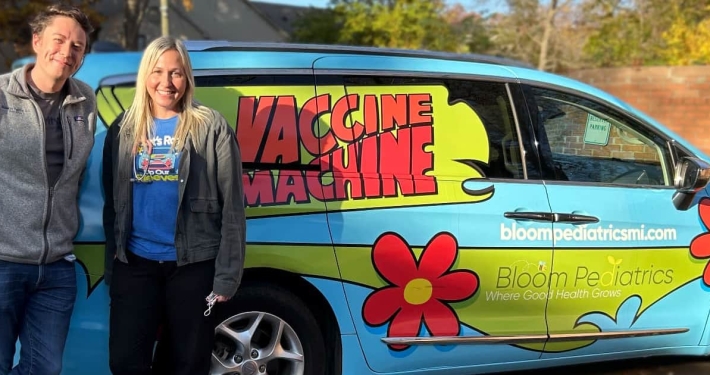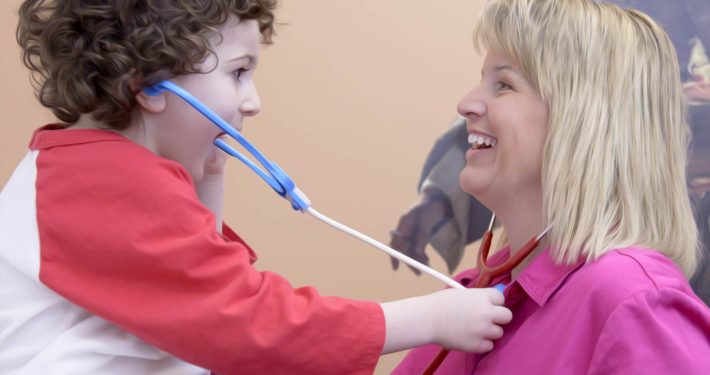Out of the Exam Room and Into the Community for Nash Pediatrics
In St. Louis, the name Nash is as synonymous with pediatrics as the Cardinals are with baseball.
Today, there are two fewer Nashes practicing in the city. Helen Nash, revered as the first African-American physician at St. Louis Children’s Hospital, died in 2012 at age 91. And Helen’s brother Homer, who helped pioneer the hiring of nurse practitioners, retired three years ago.
“Now that I’m in a management role, I have to plan and think ahead, and work hard to keep families connected to resources…”Dr. Alison Nash
But there are new challenges. The needs of families have changed and are more complex. Also, a mutable economy and health care system require her to adapt and reinvent — as her father and aunt once did, Dr. Nash says.
“Now that I’m also in a management role, I have to plan and think ahead, and work hard to keep families connected to resources,” says Dr. Nash.
Dr. Nash was born in 1955, the same year her father opened his first medical practice above a drug store in North St. Louis. Back then, an office visit was $3; a visit to the Nash home (about a 10-minute drive from the practice) was free, and welcome.
“This was back when doctors made house calls,” Dr. Nash said. “I remember sitting at the kitchen table in patients’ homes, and I remember we would also have families at our house. Dinner conversation involved a lot of medical talk back then.”
It wasn’t until late in high school, after a summer spent working for her father, that Dr. Nash considered a career in pediatrics.
“Back in the day, my dad was up all night returning phone calls, but he was never irritated by questions,” Dr. Nash said. “He always kept a positive attitude, and that was the takeaway for me. You could work that hard and still be happy.”
Today, Dr. Nash practices in the North St. Louis office building her father moved to in 1965. Homer Nash and other African-American physician specialists bought the property, making it a one-stop shop for the surrounding community. Most of the group have since passed away or retired, leaving Dr. Nash as one of the few independent physicians left in the area.
“Young physicians coming out of residency now tend to be going into big groups and hospital-owned situations, so independent physician practices are few and far between,” Dr. Nash said. “I am fortunate that my location is good for our patients, and I think we’re doing a pretty good job taking care of them.”
Providing Care in and for the Community
Dr. Nash and two pediatric nurse practitioners see about 50 patients a day; the numbers have grown with the business, but the patient demographic in urban St. Louis has not changed significantly in recent years. There are middle class families where one or both parents work, families living in shelters, families living with their extended families, single parent families where the parent works full time, and every iteration in between.
For the practice, reality has always dictated its whole family, whole community approach to treating and preventing illness in children. What’s changed are the types of stressors children and their parents face today, and how Dr. Nash and her colleagues address them.
“So many more social and environmental factors come into play now — issues of cyber bullying, drugs, kids getting involved in sex at an earlier age,” Dr. Nash said. “Many families are in need of and would benefit from medical or community services they don’t have easy access to or they are not aware of. We find ways to help families connect to resources and stay in touch.”

Serving patients with limited resources has also driven the practice to look for innovative ways to save money and boost efficiency. Employing pediatric nurse practitioners was not yet commonplace in 1978, when Dr. Homer Nash brought his first PNP into the office. Unlike many primary care doctors, he saw hiring nurse practitioners not as a turf battle, but as an effective way to scale his practice cost-effectively.
His prescience has since been reinforced by research. According to the 2003 study, “Who is Caring for the Underserved? A Comparison of Primary Care Physicians and Nonphysician Clinicians in California and Washington,” nurse practitioners and physician assistants can provide a substantial proportion of primary care and that they tend to be more willing to practice in underserved areas.
“Having a different point of view and being open-minded has always been very important to my father,” said Dr. Nash.
The elder Dr. Nash was also dedicated to keeping a lean staff. Some employees, like his first nurse practitioner, were former patients he helped put through nursing school.
Independent practices, like Nash Pediatrics, continue to defy the odds, as many young and female physicians are fleeing solo practice in favor of group practice.
The practice has also survived as a viable family business in uncertain times. In 2011, the year Dr. Homer Nash passed the reins to his daughter, only 30 percent of family businesses survived into the second generation, even though nearly 70 percent wanted to keep the business in the family, according to the Conway Center for Family Business.
“My dad was always a visionary, always looking ahead, and always open to helping others in whatever way he could be of the most help,” Dr. Nash said. “These decisions are part of the reason we’re still independent.”

Daughter’s Business Acumen Helps Mother’s Pediatric Practice Thrive
The local pediatric practice Dula’s grandfather, Homer Nash, founded in 1956 was, by then, seeing hundreds of children whose parents and grandparents had also once been patients of “Dr. Homer.”
“Growing up, we always had to be on good behavior. Wherever we went, people knew my mom or granddad,” said Dula, whose mother, Dr. Alison Nash, now owns the practice. “Now that I’m older, I understand why people were always so quick and happy to say ‘hi, how are you?’”
Today, at 29, Dula views the family business not only from a family perspective, but from that of an employee. She was hired in 2011 as the practice’s scheduler, then transitioned to office manager in 2013.
Dula, who holds a master’s degree in business administration, has helped increase overall revenue by staying on top of policy changes and improving coding.
“I started working for the practice to pay for school, but it’s within the past six months that I’m really seeing my MBA coming into play,” said Dula. “I’m looking into the insurance companies — who’s paying, who’s not, when are they paying, and are they a good fit for our practice.”
Dula has helped the practice recoup significant revenue previously lost to inadequate coding. Clinicians and billers, she said, are now reminded to include vaccine administration codes, as well as modifiers to well visits that include other services.
“Efficiency has increased, and the concern about not getting paid for insurances is gone,” Dula said. “But it’s not just about the financial health of the practice; we’re also in the business of taking care of patients. I now understand the impact this practice has on this demographic.”
“The practice, which treats mostly Medicaid patients, is now seeing fourth generation families. The level of care — through five decades and two owners — has remained the same, ” Dula said. She attributes the practice’s staying power, in part, to financial prudence and a family-like atmosphere among employees, some of whom have worked there more than 30 years. Word-of-mouth, Dula notes, has driven the practice’s entire patient base.
Family businesses show higher profitability in the long run, according to Family Firm Institute, Inc. (FFI), a membership association for leaders in family enterprise. The FFI notes that these businesses are less likely to raise debt, and less likely to lay people off despite a bad economy.
Dula said she will eventually leave the practice to expand her horizons, and has her mother’s blessing.
“Mom said to me, ‘I don’t want you to feel like you’re locked into the practice. If you go, I’ll be fine,’” Dula said. “What more could you ask from a parent?”








